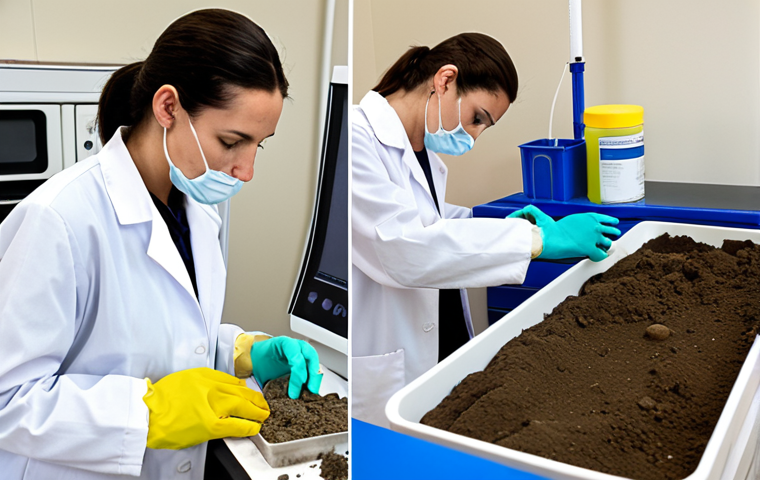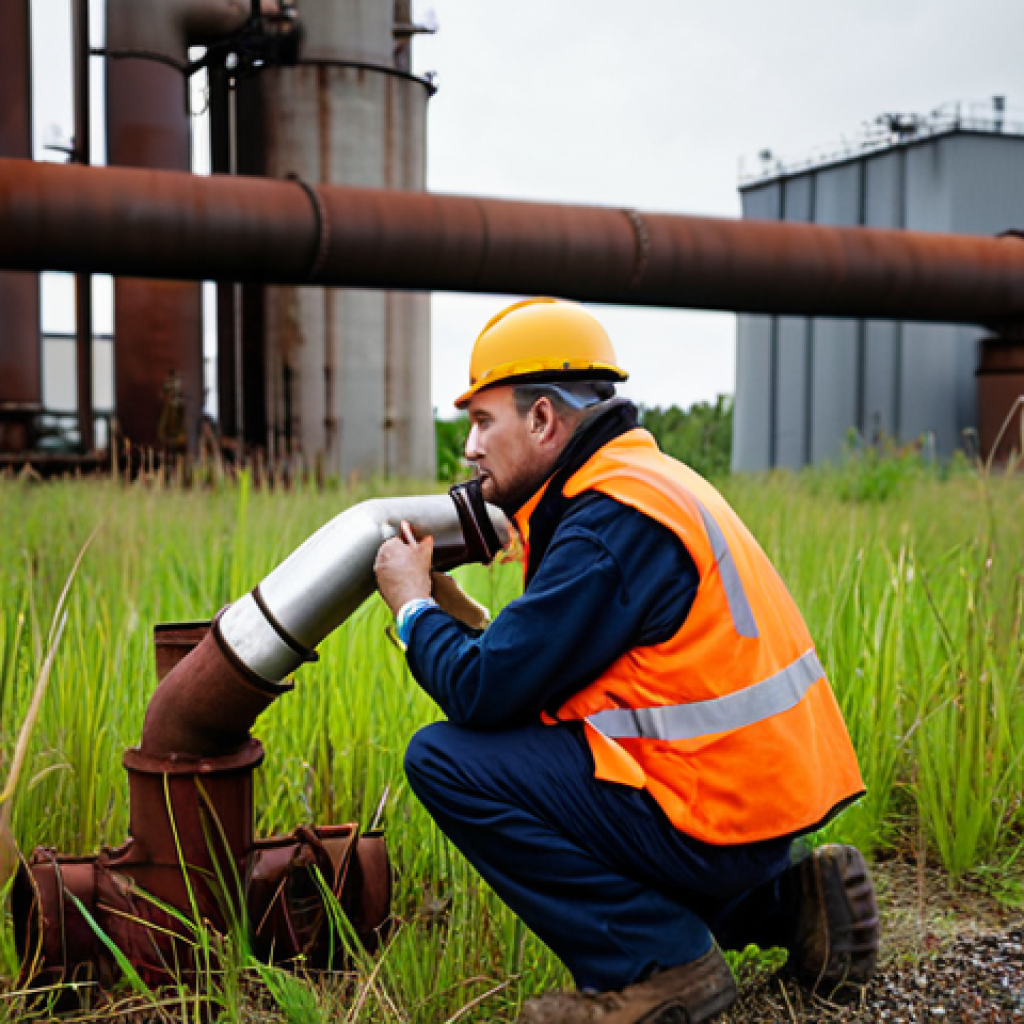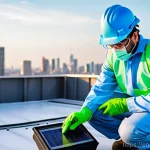Ever wonder what an environmental manager actually *does* all day? I did too, until I shadowed one for a week! Beyond the clipboards and regulations, it’s a hands-on job filled with surprises.
Think less office drone and more real-world problem solver. From water quality testing to auditing waste disposal practices, the role demands a mix of scientific knowledge and practical savvy.
It’s not just about “going green,” it’s about safeguarding communities and ensuring businesses operate responsibly, and honestly, it’s way more fascinating than I initially thought.
Let’s dive into some specific, hands-on examples in the article below!
## Diving into On-Site Inspections: More Than Just ChecklistsOn-site inspections aren’t just about ticking boxes; they’re about getting your boots dirty and truly understanding a facility’s environmental footprint.
I remember one inspection at a local manufacturing plant where I discovered a hidden discharge pipe. It wasn’t on any of the blueprints, and if I hadn’t been thorough, it would have gone unnoticed, potentially causing significant water contamination.
It’s about developing a keen eye for detail and understanding the subtle signs that indicate potential problems.
Understanding the Facility’s Processes

* How does the facility operate daily? Understanding the operational flow helps pinpoint potential pollution sources. * What types of chemicals and materials are used?
Knowing this helps identify the specific pollutants that might be present. * Where are the critical control points? Identifying these points allows you to focus your inspection on the most vulnerable areas.
Documenting Your Findings Effectively
* Taking detailed notes and photos is crucial. Imagine trying to recall specifics months later without proper documentation! * Clearly label all photos and notes, including dates, times, and locations.
* Use a standardized inspection checklist to ensure consistency and thoroughness.
Mastering Environmental Sampling Techniques
Sampling is a cornerstone of environmental management. I’ll never forget the time I accidentally cross-contaminated a soil sample with my glove – talk about a rookie mistake!
Precision and adherence to protocols are paramount. It’s not just about collecting a sample; it’s about ensuring its integrity from collection to analysis.
Water Sampling Protocols
* Understand the specific requirements for each type of analysis (e.g., pH, heavy metals, bacteria). * Use appropriate containers and preservatives to prevent sample degradation.
* Document the sampling location, date, time, and any relevant environmental conditions.
Soil Sampling Strategies
* Collect representative samples from various depths and locations within the site. * Avoid disturbing the soil structure during sample collection. * Use clean sampling equipment to prevent contamination.
Navigating the Labyrinth of Environmental Regulations
Environmental regulations can feel like a never-ending maze. I once spent weeks deciphering a complex air permit for a power plant, only to realize I had overlooked a crucial clause about emissions monitoring.
Staying up-to-date with the latest changes and interpretations is vital. It’s about understanding not just the letter of the law but also the intent behind it.
Federal vs. State Regulations
* Know which regulations apply to your specific industry and location. * Understand the relationship between federal and state environmental agencies.
* Be aware of any local ordinances that may be more stringent than federal or state regulations.
Understanding Permitting Processes
* Familiarize yourself with the requirements for obtaining and renewing environmental permits. * Understand the public participation process for environmental permitting decisions.
* Maintain accurate records of all permit applications and compliance reports.
Building Strong Relationships with Stakeholders
Environmental management isn’t a solitary endeavor. It involves working with a diverse group of stakeholders, from government regulators to community members.
I learned this the hard way when I failed to adequately address community concerns about a proposed waste incinerator. Building trust and fostering open communication are essential for achieving positive environmental outcomes.
Effective Communication Strategies
* Tailor your communication style to your audience. * Be transparent and honest in your interactions. * Actively listen to stakeholder concerns and respond promptly.
Community Engagement Techniques
* Host public meetings and workshops to gather input and share information. * Establish a community advisory panel to provide ongoing feedback. * Develop educational materials to raise awareness about environmental issues.
Leveraging Technology for Environmental Monitoring
Technology is revolutionizing environmental management. From drones that can map pollution plumes to sensors that continuously monitor water quality, the possibilities are endless.
I recently used GIS software to identify potential wetland impacts from a proposed development project, saving the company both time and money. Embracing these tools can significantly enhance your effectiveness.
GIS and Remote Sensing Applications
* Use GIS software to map and analyze environmental data. * Utilize remote sensing data (e.g., satellite imagery, aerial photography) to monitor environmental changes.
* Develop spatial models to predict the impact of human activities on the environment.
Data Management and Analysis Tools
* Use databases and spreadsheets to organize and manage environmental data. * Apply statistical methods to analyze environmental data and identify trends.
* Develop dashboards and visualizations to communicate environmental information effectively.
Mastering the Art of Environmental Auditing
Environmental audits are crucial for ensuring compliance and identifying areas for improvement. I once conducted an audit that uncovered a significant energy inefficiency at a chemical plant, leading to substantial cost savings and reduced greenhouse gas emissions.
It’s about having a systematic approach and a relentless pursuit of excellence.
Preparing for an Audit
* Review all relevant environmental regulations and permits. * Gather and organize all necessary documentation (e.g., permits, monitoring data, training records).
* Conduct a pre-audit to identify potential weaknesses.
Conducting the Audit
* Follow a standardized audit protocol. * Interview key personnel to gather information. * Document all findings clearly and concisely.
Here’s a table summarizing key aspects of environmental management tasks:
| Task | Description | Key Skills |
|---|---|---|
| On-Site Inspections | Evaluating a facility’s environmental compliance and identifying potential problems. | Attention to detail, knowledge of environmental regulations, communication skills. |
| Environmental Sampling | Collecting and analyzing environmental samples to assess pollution levels. | Technical expertise, adherence to protocols, data analysis. |
| Regulatory Compliance | Ensuring that a facility operates in accordance with all applicable environmental regulations. | Knowledge of environmental law, communication skills, attention to detail. |
| Stakeholder Engagement | Building relationships and communicating with stakeholders to address environmental concerns. | Communication skills, active listening, conflict resolution. |
| Environmental Monitoring | Using technology to track environmental conditions and detect pollution. | Technical expertise, data analysis, GIS skills. |
| Environmental Auditing | Systematically evaluating a facility’s environmental performance. | Knowledge of environmental regulations, attention to detail, analytical skills. |
Crafting Effective Environmental Management Plans
A well-crafted environmental management plan (EMP) is the roadmap for achieving environmental sustainability. I once helped a small business develop an EMP that not only improved their environmental performance but also enhanced their brand image and attracted new customers.
It’s about setting clear goals, defining measurable targets, and implementing practical strategies.
Setting Environmental Goals and Objectives
* Align your goals with your organization’s overall business strategy. * Set SMART goals (Specific, Measurable, Achievable, Relevant, Time-bound). * Prioritize goals based on their potential environmental and economic impact.
Developing Action Plans
* Identify specific actions to achieve each goal. * Assign responsibility for each action to a specific individual or team. * Establish a timeline for completing each action.
I hope that provides a helpful look into the real-world responsibilities of an environmental manager! Diving into environmental management is like embarking on a quest, filled with challenges and opportunities.
My hope is that these insights shed light on the multifaceted role of an environmental manager. It’s more than just a job; it’s a commitment to protecting our planet, one inspection, one sample, one regulation at a time.
Remember, every little effort counts towards a greener, more sustainable future.
Invaluable Insights
1. EPA Resources: Explore the Environmental Protection Agency’s website (www.epa.gov) for the latest regulations, guidelines, and resources. It’s like having a cheat sheet for environmental compliance!
2. Local Environmental Groups: Connect with local environmental organizations. They often host workshops, volunteer opportunities, and advocacy events.
3. Consulting a Specialist: Consider hiring an environmental consultant for complex projects or regulatory issues. They can provide expert guidance and ensure compliance.
4. Stay Updated: Subscribe to industry newsletters and journals to stay informed about emerging trends, technologies, and regulations. Knowledge is power in this field!
5. Networking: Attend environmental conferences and workshops to network with other professionals and share best practices. It’s a great way to learn from others and expand your horizons.
Key Takeaways
Environmental management is a dynamic field that requires a blend of technical expertise, regulatory knowledge, and interpersonal skills. It’s about understanding the science, navigating the regulations, and building relationships with stakeholders.
By embracing technology, staying informed, and collaborating with others, you can make a meaningful contribution to environmental sustainability. Remember, the future of our planet depends on informed, proactive environmental stewardship!
Frequently Asked Questions (FAQ) 📖
Q: Okay, so water quality testing sounds serious. What exactly does that entail, and is it as complicated as it sounds?
A: You bet it’s serious! When I saw the environmental manager doing it, it was far more involved than just dipping a test strip in a stream. They were collecting samples using sterilized equipment, logging precise locations with GPS, and carefully preserving them.
Back at the lab (a mobile one in their van, surprisingly high-tech!), they tested for everything from pH levels and dissolved oxygen to specific pollutants.
It’s a real science, and the results directly impact local regulations and community health. Trust me, it’s not something you can wing with a home kit from the hardware store!
Q: You mentioned auditing waste disposal. Does that mean checking dumpsters? What’s interesting about that?
A: Dumpsters are just the tip of the iceberg! The environmental manager I shadowed delved deep into a company’s entire waste stream. They reviewed contracts with waste haulers, analyzed manifests to track the types and amounts of waste being generated, and even inspected facilities to ensure proper segregation and handling of hazardous materials.
Think of it as a forensic accounting of garbage. The goal is to minimize waste, maximize recycling, and prevent illegal dumping, which can have serious consequences for the environment and public health.
It’s surprising how much you can learn about a business by analyzing what they throw away!
Q: This all sounds like it requires a ton of specialized knowledge. Do you need to be a scientist to be an environmental manager?
A: A science background definitely helps, but it’s not the only path. The environmental manager I observed had a degree in environmental science, but they also emphasized the importance of communication, problem-solving, and negotiation skills.
They spent a lot of time working with engineers, lawyers, and community members. Being able to explain complex scientific concepts in a clear and accessible way is crucial.
So, while scientific expertise is vital, being a good communicator and a practical thinker is what really makes an environmental manager effective.
📚 References
Wikipedia Encyclopedia






